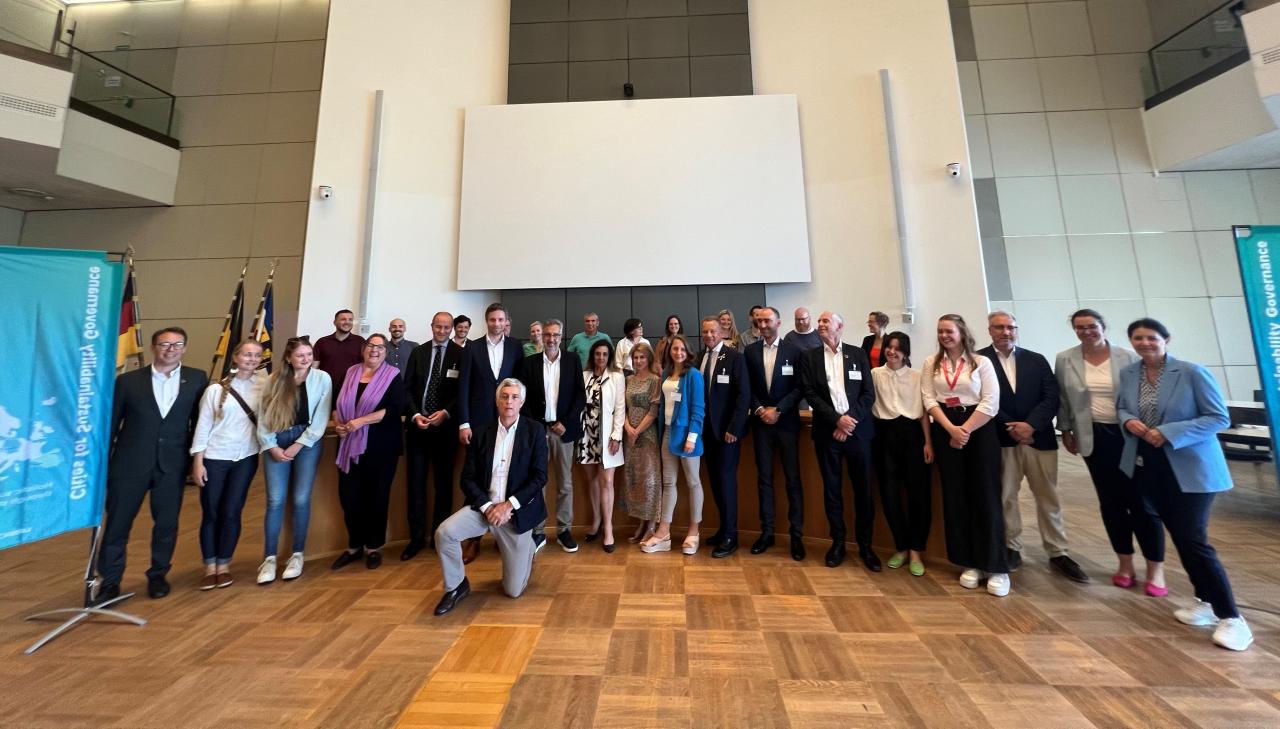
On 16-17 June, Mayors, Deputy Mayors and other significant leaders in sustainable development from CSG partner cities met in-person in the CSG partner city Mannheim, Germany. On the agenda was an intensive storytelling training with Dr Karanian from Stanford University, who introduced her approach that offers questions to participants about their motivation and emotions. Her method follows the ethos “if you want to motivate others, you first have to find your own motivation”, and uses Storytelling to help foster more collaborative and creative work environments.
Mayor and deputy mayors shared their real-life challenges through storytelling and fostered a deeper sense of connection. This experience revealed the powerful role of stories in leadership and communication. Moving forward, they will leverage these skills to lead with empathy, and impact and with a better connection with the citizens.
Watch some of the testimonials and real-life experiences from CSG Mayors and leaders here:
Following the Storytelling training, a Roundtable discussion facilitated by Prof. Louis Meuleman, was held in the City Council Hall of Mannheim. It featured mayors and other high-level representatives of the network cities as well as the Director of the URBACT programme Teofil Gherca. CSG partner city officials and stakeholders were part of the audience. The discussion was held in three rounds, reflection multi-sector, multi-level and multi-actor governance. The panel was asked to share their stories/experiences about challenges, solutions, and lessons learned on horizontal, vertical and stakeholder coordination, in three rounds:
1. Teaching silos to dance (multi-sector)
2. Working better across levels (multi-level)
3. Engagement of stakeholders (multi-actor).
Key takeaways
Below are some key takeaways from the roundtable captured by our Lead Expert Stina Heikkilä.
You can also watch the full recording from the Roundtable here:
The “soft” power of cross-sector governance
Multi-sector governance needs to be backed by “soft power” both from top-down and bottom-up. When it comes to “teaching silos to dance” – or “dancing with silos” – several of the Roundtable participants pointed to the different power dynamics that tend to be put in motion when it comes to cross-sector coordination. In the city of Tallinn, Strategy Director Raido Roop explained that there is ongoing internal debate on whether the Strategic Management Office, officially mandated to coordinate the various departments under Tallinn’s long-term strategy, has too much or rather too little power. Some see benefit in granting more than soft powers to such a coordination body, to be able to enforce more policy coherence, while others are more cautious. In Jablonec nad Nisou, Deputy Mayor Lenka Opočenská highlighted that they are in the starting blocks of bringing people from across the city administration together around the same table. They are looking for the first positive results of this in order to motivate staff to start doing things in a new, more joint-up way. Gabrovo’s mayor Tanya Hristova brought light to the need for perseverance when it comes to teaching silos to dance, illustrating the journey Gabrovo has taken over almost 10 years to become a recognised innovation player bringing together businesses, regional actors and the city administration. This journey has leaned on strong top-down commitment.
Use the leverage provided by EU projects
Mayor Tanya Hristova also highlighted how Gabrovo’s journey has been helped by involvement in EU projects ever since Bulgaria joined the EU. They provide a great context for strengthening both horizontal and vertical coordination. In Agios Dimitrios, deputy mayor Vasilis Zacharias also highlighted the benefit of being part of projects that help to bring the municipality closer to European standards of public administration. They are currently betting on digitalisation to improve both service delivery and collaboration between departments.
Gaining trust from citizens
The director of URBACT, Teofil Gherca underlined the importance of getting citizens on board with sustainability transformations, including by localising the UN Sustainable Development Goals and showing concrete medium-term results. He further highlighted that local authorities often have high levels of trust from the public, and that Mayors often fare better than national politicians in this regard. Christian Hübel, Director of Strategy and Democracy in the host city Mannheim, suggested that politicians, the city administration and the urban community operate with different logics, and that by bringing them together under a shared vision, people start to eventually follow a similar direction.
“If people are not dancing, we need to change the music” said Pedro Norton de Matos, president of Braga’s strategic council for sustainable development. He highlighted that, learning from nature, our governance systems need a quantum leap from “me” to “we” and by forgetting that there is a “them”.
Following this Mayor-level meeting in Mannheim, our network continued exploring the themes of governance styles and Storytelling as a tool to boost engagement among colleagues and citizens during two days of Core Network meeting. It emerged from the workshops that one aspect of governance that needs to be further investigated and worked upon is collaboration between the national government and local authorities. It seems like the added value from both sides of such collaboration is not always clear, and that it can be hard to translate into practice. In our next occasion, we will definitely aim to have some national government representatives around the table!

